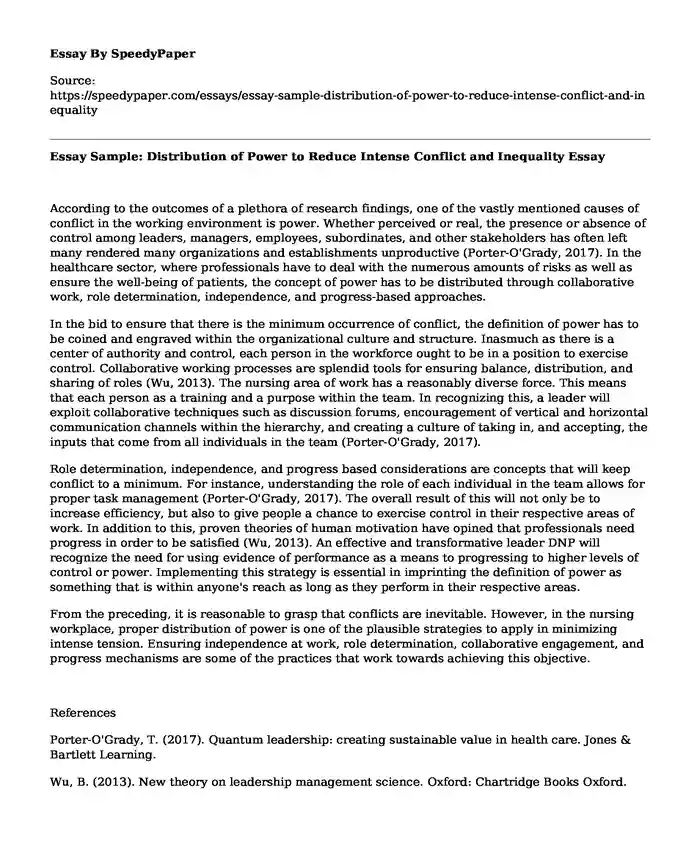
| Type of paper: | Essay |
| Categories: | Conflict management |
| Pages: | 2 |
| Wordcount: | 447 words |
According to the outcomes of a plethora of research findings, one of the vastly mentioned causes of conflict in the working environment is power. Whether perceived or real, the presence or absence of control among leaders, managers, employees, subordinates, and other stakeholders has often left many rendered many organizations and establishments unproductive (Porter-O'Grady, 2017). In the healthcare sector, where professionals have to deal with the numerous amounts of risks as well as ensure the well-being of patients, the concept of power has to be distributed through collaborative work, role determination, independence, and progress-based approaches.
In the bid to ensure that there is the minimum occurrence of conflict, the definition of power has to be coined and engraved within the organizational culture and structure. Inasmuch as there is a center of authority and control, each person in the workforce ought to be in a position to exercise control. Collaborative working processes are splendid tools for ensuring balance, distribution, and sharing of roles (Wu, 2013). The nursing area of work has a reasonably diverse force. This means that each person as a training and a purpose within the team. In recognizing this, a leader will exploit collaborative techniques such as discussion forums, encouragement of vertical and horizontal communication channels within the hierarchy, and creating a culture of taking in, and accepting, the inputs that come from all individuals in the team (Porter-O'Grady, 2017).
Role determination, independence, and progress based considerations are concepts that will keep conflict to a minimum. For instance, understanding the role of each individual in the team allows for proper task management (Porter-O'Grady, 2017). The overall result of this will not only be to increase efficiency, but also to give people a chance to exercise control in their respective areas of work. In addition to this, proven theories of human motivation have opined that professionals need progress in order to be satisfied (Wu, 2013). An effective and transformative leader DNP will recognize the need for using evidence of performance as a means to progressing to higher levels of control or power. Implementing this strategy is essential in imprinting the definition of power as something that is within anyone's reach as long as they perform in their respective areas.
From the preceding, it is reasonable to grasp that conflicts are inevitable. However, in the nursing workplace, proper distribution of power is one of the plausible strategies to apply in minimizing intense tension. Ensuring independence at work, role determination, collaborative engagement, and progress mechanisms are some of the practices that work towards achieving this objective.
References
Porter-O'Grady, T. (2017). Quantum leadership: creating sustainable value in health care. Jones & Bartlett Learning.
Wu, B. (2013). New theory on leadership management science. Oxford: Chartridge Books Oxford.
Cite this page
Essay Sample: Distribution of Power to Reduce Intense Conflict and Inequality. (2022, May 22). Retrieved from https://speedypaper.net/essays/essay-sample-distribution-of-power-to-reduce-intense-conflict-and-inequality
Request Removal
If you are the original author of this essay and no longer wish to have it published on the SpeedyPaper website, please click below to request its removal:
- Technology Management Plan. Free Essay Example.
- Essay Example on Quantum Computing
- Essay Sample with the Discussion on Personal, Professional and Cultural Awareness
- Homeland Security Improvement, Free Essay for Everyone
- Essay Sample about Middle Power Concept in Australian Foreign Policy
- Essay Sample on the Chief Ethics Officer
- Essay Example: Project Management - Team Building
Popular categories




